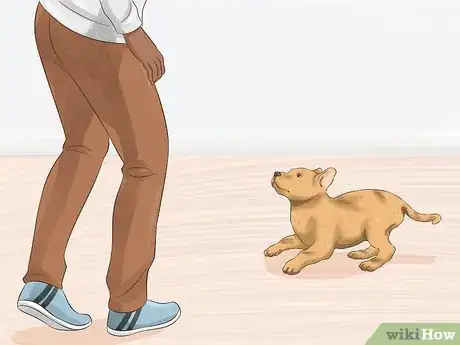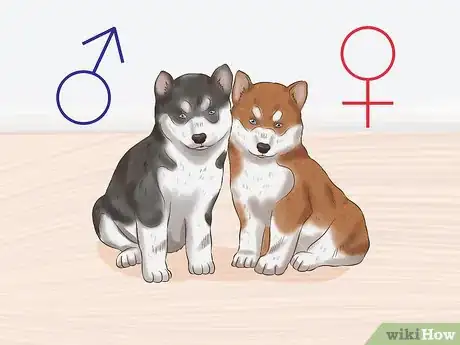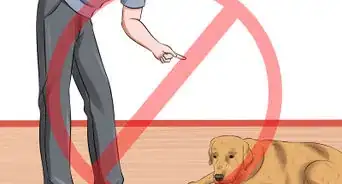This article was co-authored by Melissa Nelson, DVM, PhD. Dr. Nelson is a Veterinarian who specializes in Companion and Large Animal Medicine in Minnesota, where she has over 18 years of experience as a veterinarian in a rural clinic. She received her Doctor of Veterinary Medicine from the University of Minnesota in 1998.
This article has been viewed 29,689 times.
Choosing a puppy from your litter can seem like a daunting task. You have watched them since they were born and helped raise them the last few weeks. Though you may have a favorite or want them all, picking a puppy to make into your pet should be a reasoned decision. To choose your puppy, evaluate their individual personalities, watch them interact with the litter, and interact with them alone to discover how the puppy will be around your family.
Steps
Evaluating the Puppy’s Personality
-
1Choose a puppy with a balanced personality. Often, the best pets are the ones that have balanced personalities. You may not want the bossy, strongest puppy who seems to be the leader or the shy runt who gets left behind. Instead, you may want to look for a puppy who falls in the middle of the personality scale. This puppy may be energetic, but also knows how to be calm and mind. You might want to consider:
- How well does the puppy play with their littermates? Are they rough and assertive, or do they run and hide?
- Is the puppy very loud and boisterous or soft and quiet?
- Does the puppy like to be touched and handled?[1]
-
2Avoid suspicious or skittish puppies. When choosing a puppy from your litter, you may want to pass on the puppies that seem distrustful of strangers or who shy away when you approach. These puppies may become shy and easily startled dogs.[2]
- Check to see if the dog is skittish by clapping your hands, dropping your keys, or making any other loud sound. If the dog reacts in a scared way, they may be a skittish, fearful dog.
- If you have children, skittish and shy puppies are probably not the best choice. They may snap at your children.
Advertisement -
3Refrain from immediately choosing the most enthusiastic puppy. Many people believe you should choose the puppy who is the most energetic or the one who runs up to you. While you may end up liking this puppy best in the end, you shouldn’t choose this puppy before you evaluate all of the puppies. Many great potential pets may be the puppies who are hanging back patiently. Don’t overlook those puppies. Instead, look at each puppy carefully and decide if you want the most energetic or a calmer, shier puppy.[3]
- Carefully hold the puppy in your arms. Does it stay there calmly for you, or does it wiggle around? Place the puppy on its back on your lap. Does it lay there, or does it squirm and try to flip back around? If the puppy squirms or tries to get out of your grasp in either of these positions, you may have an enthusiastic, willful puppy.
- Energetic puppies may be too much for you after a few days. An energetic puppy will continue to be energetic after you take it home.
Interacting with the Litter
-
1Watch the puppies interact with their littermates. Puppies are all inquisitive and like to chew or crawl on you. But each puppy has a different personality, which can be easily figured out by watching the puppies interact with each other.[4]
- You can tell by watching the interaction which puppies are strong, bossy, or noisy, which are quiet or gentle, and which seem like they get picked on.
-
2Interact with the puppy away from the littermates. After watching the puppies with their littermates, separate them. The puppy may change their behavior when not around others. You can get a better sense of what they will be like as your pet if you separate them.[5]
- Play with the puppy, call it to you, hold it, and interact in ways you believe you would interact with it at your home. This can give you a sense of what the puppy will be like when you get it home.
- For example, quiet, gentle dogs may be more energetic when not around others, and energetic puppies may calm down when not influenced by the other puppies.
-
3Take your time choosing a puppy. Since you are choosing a puppy from your own litter, you can take the time to really watch the puppies and interact with them. Play with them. Study how they react to you and your family. Watching the puppies for a few days to a few weeks can help you determine which dog is right for you.
- Get down on the floor and call the puppies to you. Do this multiple days to see how they react each time you interact with them.
- Encourage your family to interact with the puppies to get a sense of how they will fit into your home.
- You should spend at least 30 minutes a day with each puppy once they are three weeks old. This can be broken up into short handling sessions throughout the day. This will help you get to know each puppy.
Addressing Other Considerations
-
1Determine if you want a male or female. This decision is important for many people. Females are generally smaller in size than males, and they tend to be less dominant and don't roam away from their home as often. By getting your puppy spayed or neutered, you won’t have to worry about pregnancy or reproductive diseases. This decision will be personal and up to you.[6]
- Some people may choose the sex of their dog based on other dogs they have. For example, you may want a female dog because you have a male dog and don't want another. Others prefer female dogs who don’t mark their territory.
-
2Wait until the puppy is at least six weeks old. Puppies need to be at least eight weeks old before they leave the litter. While you should be searching for potential homes once the puppies are born, you shouldn’t try to sell or give away puppies in your litter until they are at least eight weeks old. While you may have become attached to all the puppies, you shouldn’t choose one for yourself until around six to eight weeks of age.[7]
- By this age, the puppies begin to look like they will when they become an adult. This is the age they start to show their individual characteristics and their temperaments.
-
3Choose a puppy that is healthy. It is extremely important to choose a healthy puppy so it will grow into a healthy dog. Even if you’ve done everything you can to keep the puppies healthy, there may be weaker ones in the litter. Evaluate them carefully to make sure your choice is healthy.[8]
- Make sure your choice has a smooth, healthy coat and that their eyes are clear without discharge. Make sure the ears don’t have an infection.
- Every puppy in the litter needs to visit the vet to be evaluated for health issues, dewormed, and vaccinated. It is also highly recommended that you spay and neuter all puppies to prevent unwanted litters.
References
- ↑ https://vcahospitals.com/know-your-pet/choosing-the-right-puppy-from-a-litter
- ↑ http://dogtime.com/dog-health/general/383-choosing-purebred-puppy
- ↑ http://dogtime.com/dog-health/general/383-choosing-purebred-puppy
- ↑ http://www.yourpurebredpuppy.com/buying/articles/how-to-choose-a-puppy.html
- ↑ http://www.yourpurebredpuppy.com/buying/articles/how-to-choose-a-puppy.html
- ↑ http://www.canismajor.com/dog/pikpup.html
- ↑ http://www.about-cocker-spaniels.com/choosing-a-puppy.html
- ↑ http://www.about-cocker-spaniels.com/choosing-a-puppy.html
About This Article
Before you choose a puppy to keep from your litter, watch how they interact with each other. Avoid puppies that appear suspicious or skittish, since they may grow into shy and easily startled dogs. After watching the puppies with their littermates, interact with each one separately to get a sense of what they will be like as a pet. Since you’re choosing a puppy from your own litter, take the time to spend at least 30 minutes a day with each puppy to see how they will fit into your home. For more advice from our Veterinary co-author, including how to choose a puppy with a balanced personality, keep reading!





































































